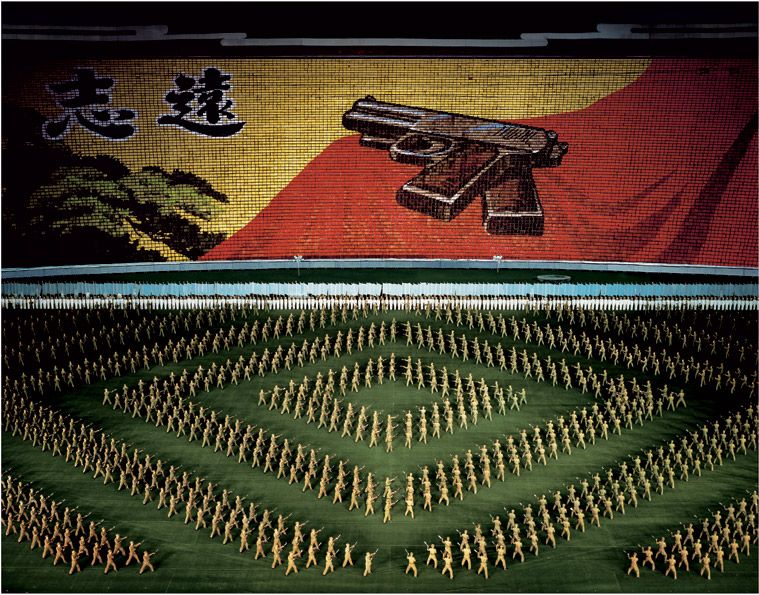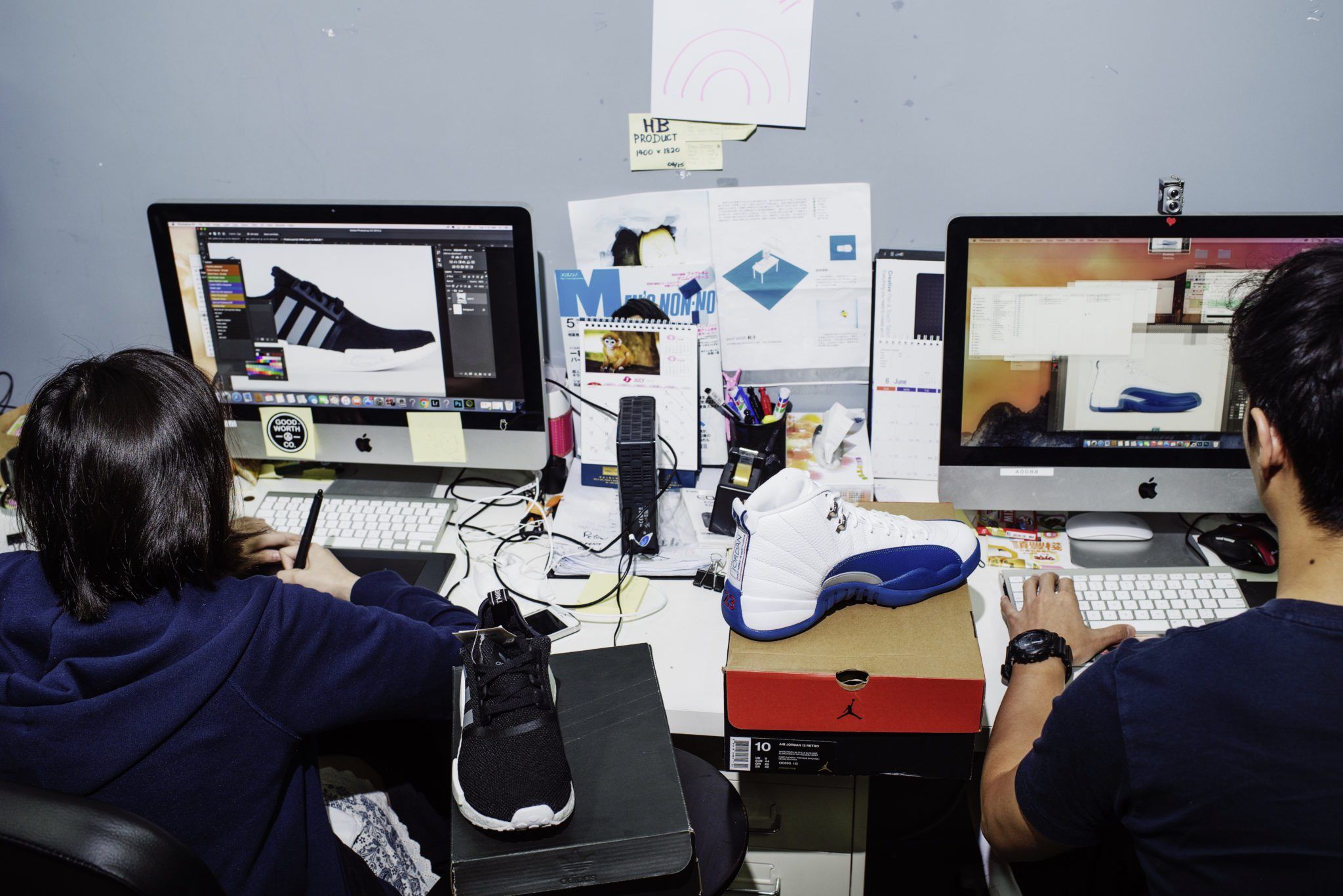How Do I Feel More? A Weekend With JORDAN WOLFSON
|Thom Bettridge
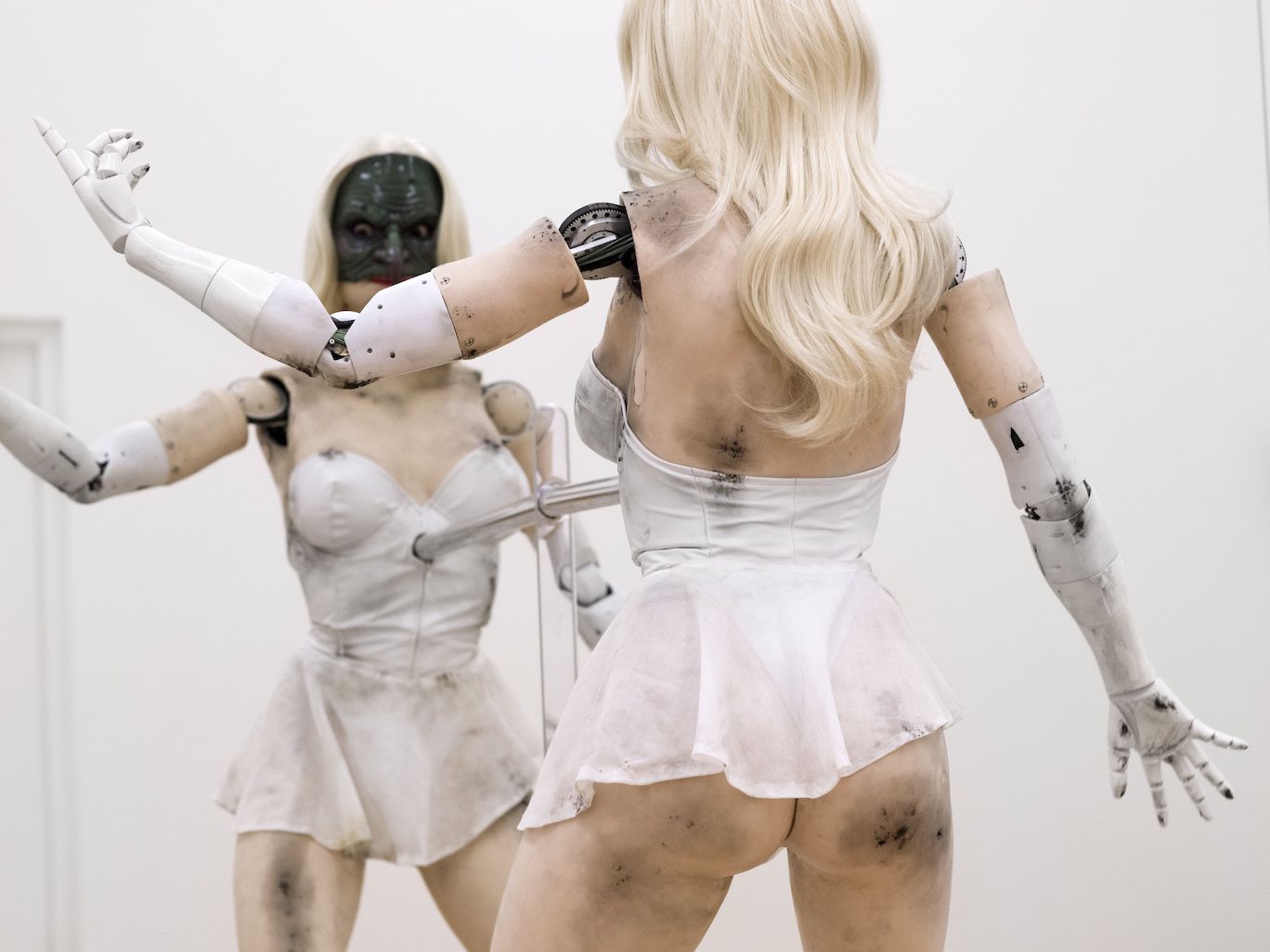
The afternoon is hot and artificially bright. Sighs of breeze whoosh through the verdant fields, punctuating a monotonous drone of insects. Jordan Wolfson and I pace together in the musty shade – he in a pair of white Moschino shorts, I in a stifling dark suit – inspecting an empty farmhouse that he has just purchased in Upstate New York. “I want to knock this wall down,” the 36-year-old artist tells me, “And this wall down. And that wall down. I just want this whole thing to be a big. Fucking. Room.”
Outside, we take a ride across the property with a contractor and Wolfson’s real estate broker. Their pickup truck carves doodles into the tall grass. We all get out at the property’s highest point, overlooking a rolling field. Here, Wolfson and his associates conspire to lift the farmhouse, which sits at the bottom of the hill, put it on a truck, and place it onto a concrete pedestal right where we stand. The artist is at work, “Is it also possible to make that pond bigger and deeper?”
“It’s easy to make it bigger,” the contractor shrugs, “but hard to make it deeper.”
As the two of us leave the farmhouse in Wolfson’s car, we listen to a podcast of Bret Easton Ellis interviewing Larry Clark about the making of Bully – war stories about herding drug-addicted child actors and telling movie studios to fuck off. In an iMessage before we met up, Wolfson asked that the make and model of his car remain off the record. On this ride, he decides it would be funny to admit that he drives a Tesla.
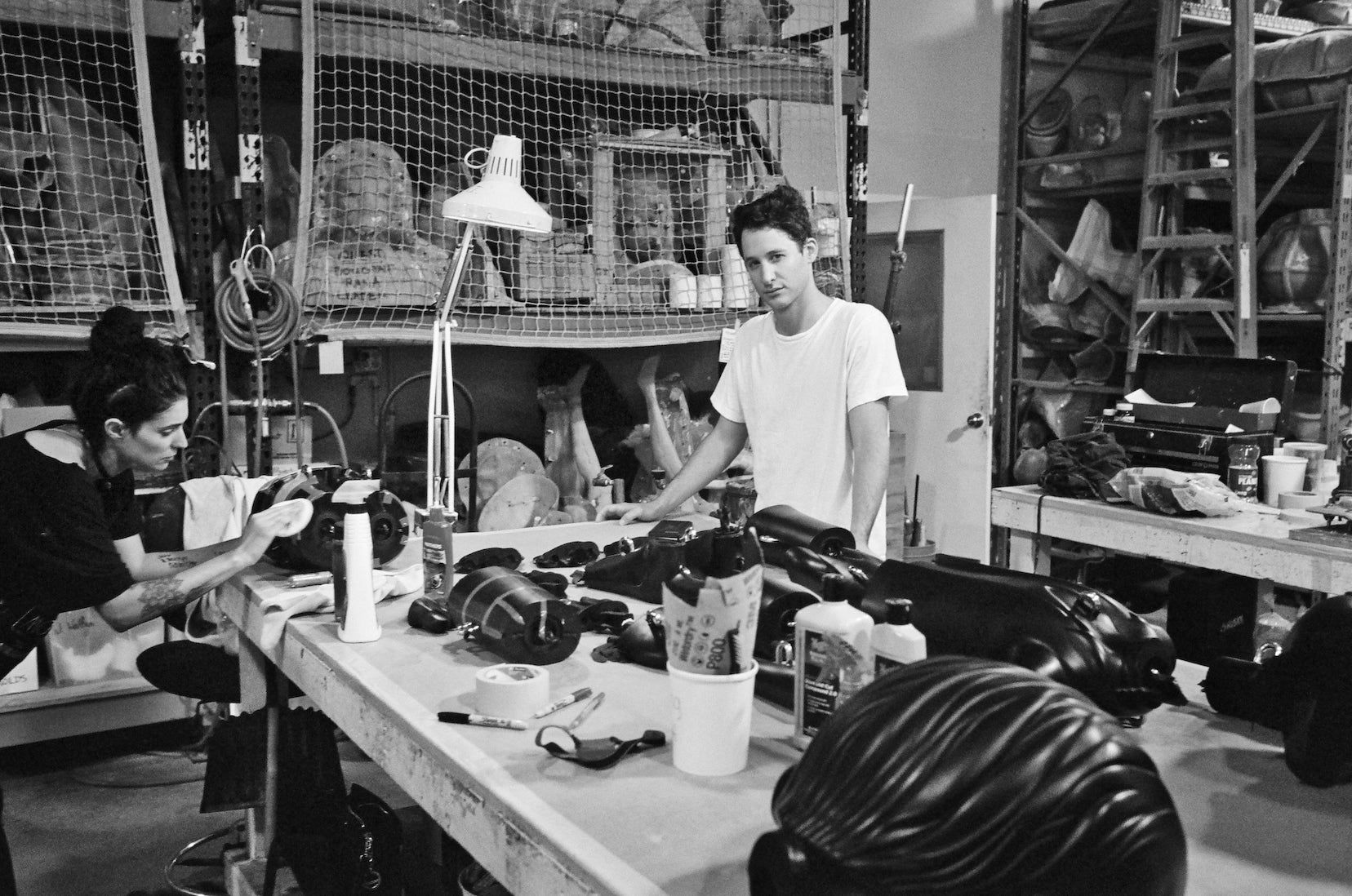
We hum back toward New York City, where his artwork Real Violence (2017) at the Whitney Biennial is igniting droves of perplexed and horrified reviews. In an exhibition clouded by Dana Schutz’s controversial painting of Emmett Till, some thought Wolfson’s virtual reality film of himself savagely beating an anonymous hostage with a baseball bat deserved even more attention.
As we near the Lincoln Tunnel, I ask Wolfson about the value he places on transgression. He points to Vito Acconci’s Seedbed (1972), a famous performance piece in which the artist masturbated under a ramped floor inside a gallery. Wolfson takes his eyes off the wheel, locking them directly into mine:
JORDAN WOLFSON: What if I got really angry with you right now without any context? And it was real anger. What would you say?
THOMAS BETTRIDGE: I’m not sure.
Would you say I’m schizophrenic?
Perhaps.
And how would you describe someone who is masturbating in public? What would you say?
I’d say that person is unhinged.
And how would you describe the experience of seeing it?
I would say it’s surreal.
And what makes something like that disturbing?
Tell me.
That. It. Is. Actually. Real. And that was my idea. That rupture as an art experience.
At a noisy Korean-Italian fusion restaurant in the West Village, Wolfson and I hunch over a tape recorder, running through his life story and taking breaks to try dishes such as Dungeness Crab Gnocchi. Wolfson made the reservation and was sure to order the Steak for Two in advance, requesting that they not cut off the fat. As a child, Wolfson had trouble in school but discovered an aptitude for art. He remembers wanting to “go big, creatively” as an artist from a young age – maybe be a painter, maybe something else.
As an undergraduate at Rhode Island School of Design, he made an early film using footage of Andy Warhol spliced with a close-up of his own face. “I already thought of myself as a serious artist back then,” Wolfson says. Despite famous peers such as Ryan Trecartin and Dan Colen, the overall environment at RISD did not feel “serious” enough to him. He moved to Stockholm to study at Konstfack, where he did his first exhibition at Galleri Brändström & Stene at the age of 22.
Even after a glass of mezcal, Wolfson’s recall of his own career is startlingly granular: the name and location of every single exhibition, specific conversations with artist-mentors who helped him along the way, the exact circumstances of how he met a curator like Beatrix Ruf, or how he parted ways with a gallerist like Johann König. Without any sense of regret, he describes his 20-something self as being “intensely ambitious, maybe to a fault.” This aspirational desire bubbles up to the point of self-parody in his early film The Crisis (2004). In it, a young Wolfson donning glasses and a Mark Zuckerberg-esque hoodie paces around a cathedral, rattling off a list of artists he admires and wondering out loud how he can be like them: “What does it take? Is it practice?”
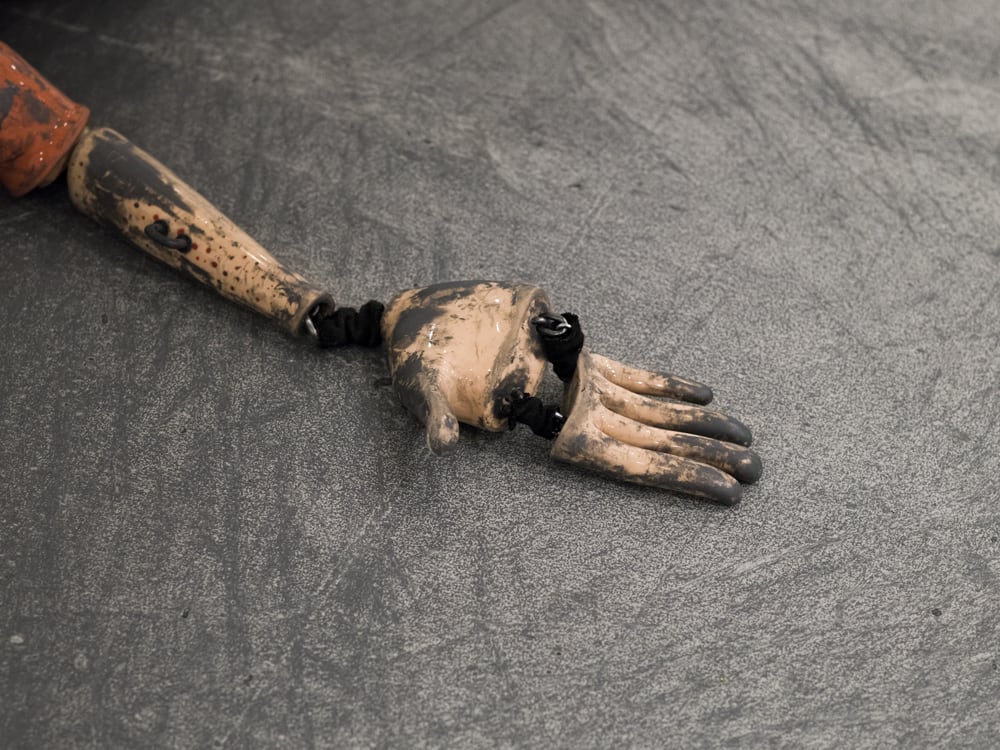
In real life, Wolfson socialized and hustled to the point of Faustian dread. This state of career-oriented anxiety culminated with his first appearance at the Whitney Biennial in 2006. There, he received his first bad review. “It said the work was a ‘didactic one-liner,’” he quotes, “I felt humiliated. Horrified. I had negative people around me and I started to live in a cocoon of self-censorship. I felt like I had lost my magic.”
It was around this time when Wolfson decided to get an exorcism. He read Michael Crichton’s Travels, a memoir in which the Jurassic Park author meets a channeller and begins practicing astral travel. Wolfson, on his part, ended up finding a balanced regimen of exercise, meditation, and psychic readings that he maintains faithfully to this day: “I have this tarot card reader and I tell her about my work like crazy. ‘What about version one? What about version two? What about version three?’ If it’s going to up my chance of the work being better, I’m there. I’ll do anything. You name it. I used to go to Bikram yoga and I would hold poses with the promise that if I held this pose, I would be able to figure out the artwork.”
Wolfson describes making art as a cognitively draining process, one that involves an overwhelming level of focus that sometimes frays his personal relationships. From early on, his work has entailed managing teams of assistants, animators, and contractors. He explains that hired experts allow him to achieve the fluid and professionally packaged quality that he associates with animation – a childhood fascination of his.
In Wolfson’s video work, animations often overlay representations of himself, standing in for a type of disconnected subconscious. Raspberry Poser (2012) features animated HIV viruses bouncing in empty suburban homes interposed with vignettes of the artist dressed as a caricature punk, smearing dirt on himself and walking around the Eiffel Tower with a baguette. In Con Leche (2009), a cavalcade of Coke bottles filled with milk march over an audio track of Wolfson directing a female actress. Droplets of milk slosh out the tops of their bottles as she reads a script that sounds like his own diary. In each case, animation serves as an element that simultaneously seduces and refracts, spinning a mirage of meaning imported from a Disney-like nowhere.
Wolfson compares the slick packaging of these animated forms to the feeling of eating a store-bought sandwich, indulging in an absence of the hand that can only come from specialized experts. As such, his process is one of consuming the media he commissions on a massive scale, modulating it through the labor of others, and then imbibing the results again and again with a focus on his own reaction. Wolfson watches his pieces hundreds of times, asking for greater and greater levels of intensity as he fights the feeling of being left numb. The end result is a product built through consumption, one that penetrates into an emotional stratosphere of sex, irony, shame, and violence.
“I want to feel more. Where do I feel more? How do I feel more? It was all about feeling more. Turning the volume up and down.”
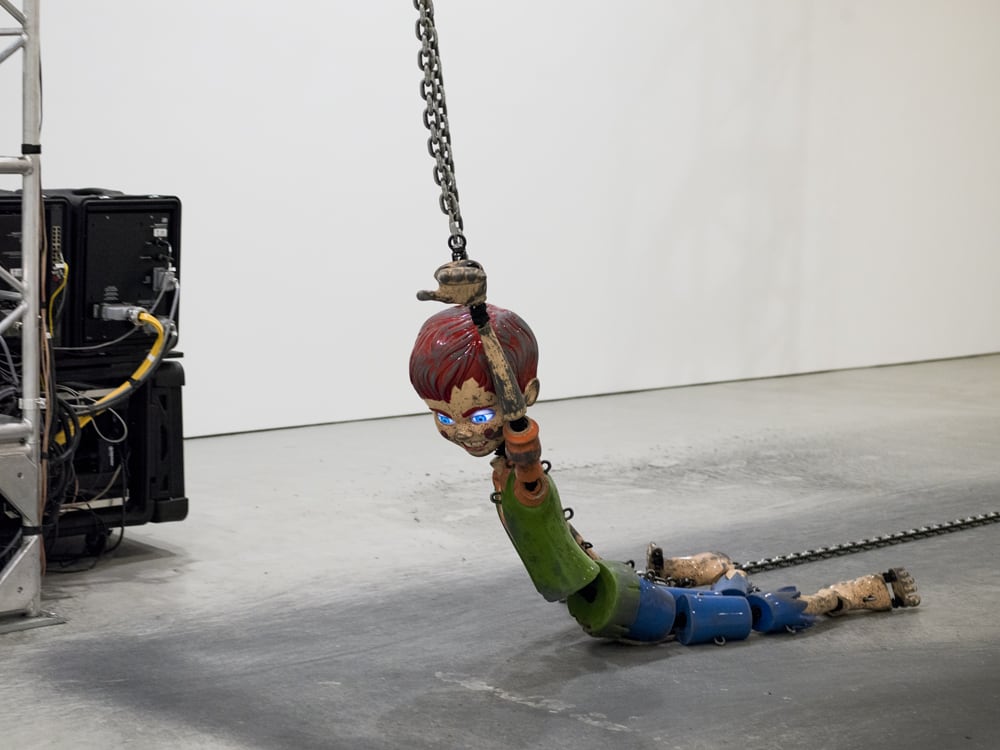
In 2013, Wolfson made a trip to the Disney World Hall of Presidents, where an animatronic statue of Barack Obama served as the inspiration for a perversely ambitious project. Seeing the statue triggered a powerful yet completely unintellectual feeling in him. He was infatuated by its form, by the manner in which the fake Obama’s hands moved. The sculpture contained a staged physicality that felt something other than real. The experience led Wolfson to conceive (Female figure) (2014), a ghoulish animatronic woman who dances in front of a mirror to songs by Paul Simon and Lady Gaga. At this time, he had just joined the blue chip stables of gallerists Sadie Coles and David Zwirner. Wolfson rushed to his new dealers with a hard sell: He had to make this artwork, and it was going to cost hundreds of thousands of dollars.
THOM BETTRIDGE: Immediately after you and Jordan started working together, you embarked on an enormous project. Did (Female figure) feel like a risk to you?
DAVID ZWIRNER: Let me put it this way: When he walked in and pitched the idea, I was glad I wasn’t a young gallerist. There was a lot of risk there. And he was asking for a disproportionate amount of money given the place he was in his career. Meanwhile, the piece seemed so strong, and the way he spoke about it was so convincing, that it didn’t take me very long to say yes.
There must be a certain attraction to the level of confidence it takes to ask for something like that.
It was surprising. You always expect young artists to be a little humble – because they are young artists. But, of course, that’s not how it works. He came on very, very strong and then delivered. I mean, that was one of the seminal works that any artist has made in the past ten years. I think it’s iconic and I was proud to be a part of it.
When (Female figure) debuted at David Zwirner Gallery in 2014, it was a bizarre and unique spectacle. The sculpture could only be visited in small groups by appointment. But through the then-new capabilities of Instagram video, Wolfson’s undulating masked woman took on a parallel life in the public consciousness. It was almost a monument to this digital Zeitgeist, fit for a generation that could closely relate to the condition of being welded to a mirror. Coles and Zwirner’s gamble paid off. All three editions of (Female figure) were sold to Peter Brant, Eli Broad, and two joint buyers in New York.
“The piece had an uncanny presence of being,” artist Jeff Wall remembers about the sculpture, “It’s not something you see often. Paul McCarthy has done animatronic pieces, but they don’t have the content that Jordan’s has. I hate to compare artworks as one being better than the other, unless they really are better than the other. And the woman in front of the mirror displayed an emotional element that impressed me. Jordan isn’t doing something that hasn’t be done before. He’s just doing it well.”
With the help of special effects artist Mark Setrakian and a crew of experts, Wolfson was able to automate his sculpture to lock eyes with its viewers. Eye contact is a frequent motif in Wolfson’s work, one that he describes as creating a “formal bridge” that fosters identification with the audience. At the end of (Female figure)’s looped routine, in one such moment of shared gaze, she lip-syncs Wolfson’s own voice:
“When you look at yourself, you’re ugly. When you touch yourself, you’re hot. I’m getting old. I’m getting fat. And I don’t believe in God.”

“Can I say I don’t believe in God? I didn’t know if I could. And it gave me this weird existential crisis,” Wolfson recalls during our car ride, “And then I was like, ‘Fuck it. I don’t believe in God.”’ The artist smirks and accelerates around a bend. Much like eye contact, calculated breaks in the fabric of political correctness are another tool Wolfson repeatedly deploys in his work. These ruptures serve as a counterpoint to his “formal bridge” – creating a sense of alienation, discomfort, and disrupted meaning. Wolfson remembers shrugging off friends who told him to “be careful” when he began printing gay pornography and images of the September 11th Attacks onto lobster claws in 2012. This irreverence surfaced again in the Shylock-like main character of Animation, masks (2011). And again in the racist double entendre of his title for Colored sculpture (2016), which Wolfson conceived on a flight out of Basel in 2014.
Very much a sequel to (Female figure), Colored sculpture was a red-headed dummy suspended by chains from a steel frame above the gallery floor. As the chains move and unfurl, the painted rubber figure is twisted through a detailed choreography. The sequence begins with the boy hanging from his hand, being slowly raised, and then crumpled onto the ground in a gentle, almost balletic, rhythm. Nine minutes in, Percy Sledge’s “When a Man Loves a Woman” begins blaring through the speakers. The chains pick up their pace, rattling as they quickly pull the boy by his foot toward the ceiling, before going slack and dropping him directly on his head. He then gets pulled toward the front of the frame, pausing with his sectioned body on full display, his rabid and glowing animatronic eyes searching for an audience.
“You know, the steak is pretty chewy. I get why they normally cut off the fat.”
Eye contact and alienation – this combination allows Wolfson to open his audience up and download something uncomfortable inside them. The result is the feeling of watching a car crash, or rather, the feeling of realizing that you are watching a car crash and that you might not care. Colored sculptureturns a gallery into an arena of torture, one in which white walls lend the audience permission to watch, even to indulge. Because it is not quite real. Or is it? I pose the question to Wolfson as we tear into our steak.
JORDAN WOLFSON: That’s where the title of Real Violence came from. It was during that scene in Colored sculpture where the object starts getting repeatedly smashed into the ground – where it’s getting brutally assaulted by the mechanism. Had there been a human attached to the chains, it would have killed him immediately. When I saw that, I said to the team, “We’ve achieved real violence.”
THOMAS BETTRIDGE: And what’s fake violence?
When we first started Real Violence, we made a test with stunt guys beating up other stunt guys. And it looked so fake. It was so boring. And I was like, “Well, I would never want to beat any of these stunt guys up like that, ever.” I would never want to hurt someone physically, ever. But then I kept on seeing these face-swapping videos on Instagram, and I was like, “Why don’t we build an animatronic dummy and face-swap onto it?” And then I could really beat the fuck out of that thing.
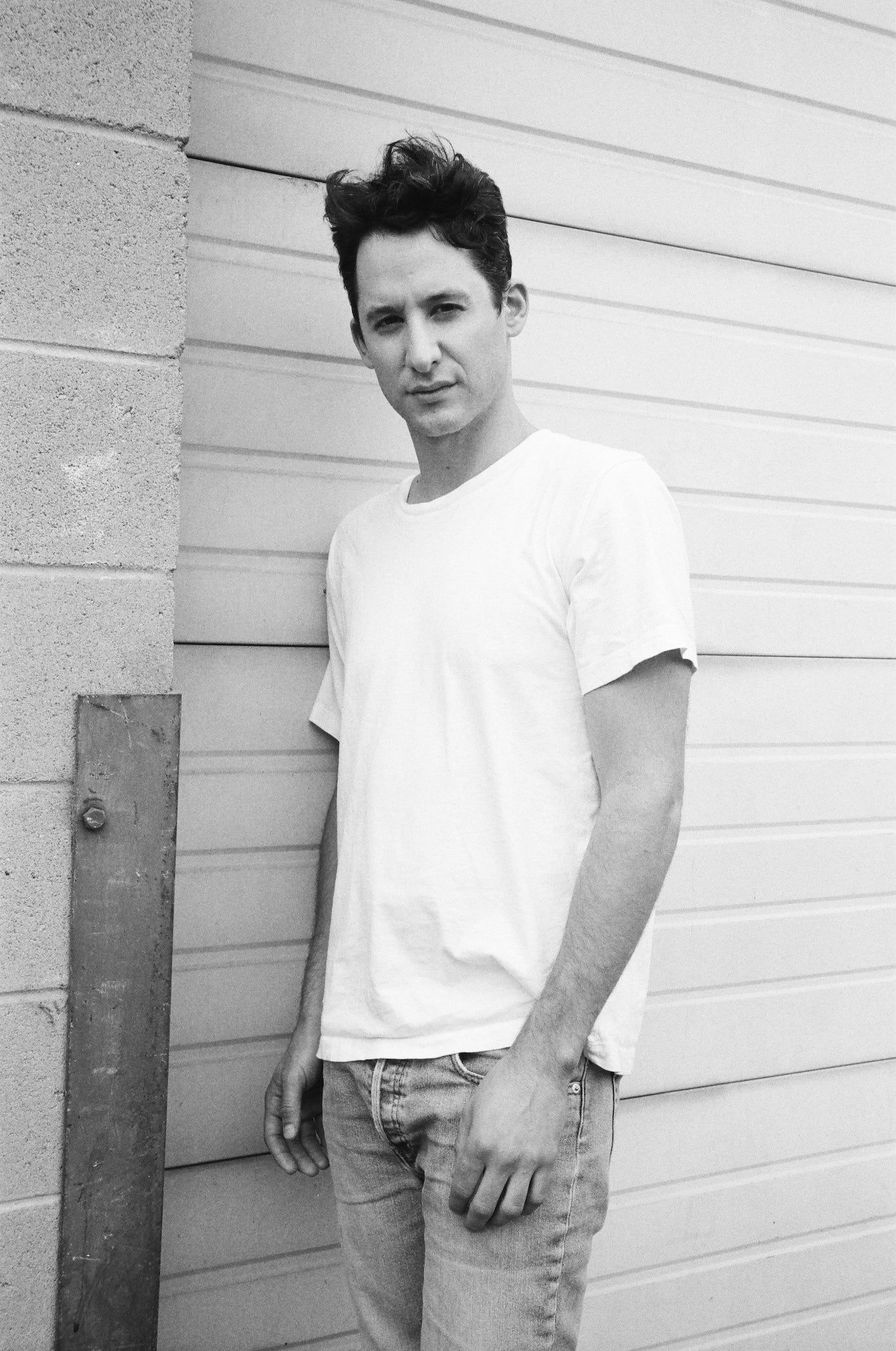
Putting on a headset at the packed Whitney Biennial to watch Real Violence, I noticed that the glass of my Oculus Rift display was slightly fogged from the sweat of the person before me. The film begins with a disorienting POV backflip that turns you slowly as Wolfson’s voice says the Jewish Hanukkah prayer. You then find yourself standing on a nondescript city street. Wolfson stands in front of you, eyes fixed on yours, holding a baseball bat. A red-headed boy kneels to his left, he stares at you as well, silently pleading for help. Wolfson then proceeds to swing the bat into the boy’s skull and commences beating his body, sometimes stomping, sometimes kicking, again and again, until the boy goes limp, and the screen cuts to black. Only while watching the film a third time, did it dawn on me that, with the capability of 360-degree video, it was completely possible to turn my head and not look at the grotesque sight in the center of the film. I continued to watch anyway.
DAVID ZWIRNER: The way you are supposed to interact with Jordan’s work as an audience is very new and very ambiguous. You’re not led to a particular position where you would say: “Okay, I’m empathizing. I’m sad. I’m happy.” You’re constantly whiplashed. We are obviously in this Internet moment now, and any new medium brings a new sensibility to us – telephone certainly did, radio did, television did. And they all had a quite clear connotation. The Internet doesn’t have that at all. Because you can go from an image of a beheading to an image of a bunch of little puppies – you can go from gruesome to cute in a click. And that cold vibe is very evident in Jordan’s work. He’s not giving you a position. You’re on quicksand.
Unlike (Female figure) and Colored sculpture, Real Violence was not Instagramable. Instead, its spectacle was shared through the lore of testimonial accounts, all of which could not quite encapsulate its finely calibrated combination of banality and horror. In the recent years, “viral” videos of violent death have become increasingly frequent and well-circulated. ISIS beheadings have become a constant sight in the darkest corners of the Internet. In 2016, the police murder of Philando Castile was streamed live on Facebook. And this summer, footage of an avowed Nazi driving his car into a crowd of counter-protesters in Charlottesville, Virginia was put on loop across international news outlets.
At the same time, young white men – typically beta males and often media super-consumers – have transformed into far-right ideologues and mass-shooters on a larger and larger scale. While Wolfson himself does not ascribe to these beliefs, Real Violence arises from a similar thirst for senseless rupture, mining a void between the violent extremity of media and the impotence of everyday life. Young white men – like Wolfson, like myself – are rarely ever the victim of violence. Instead, they are often afflicted by violence’s (by no means equal) opposite: boredom wrapped in a web of pornography and existential angst. This is the condition that causes one to want to search for ruptures in social decorum. It is the condition that causes one to want to “feel more.” And it is the condition that leads to the world’s most institutionally backed snuff film.
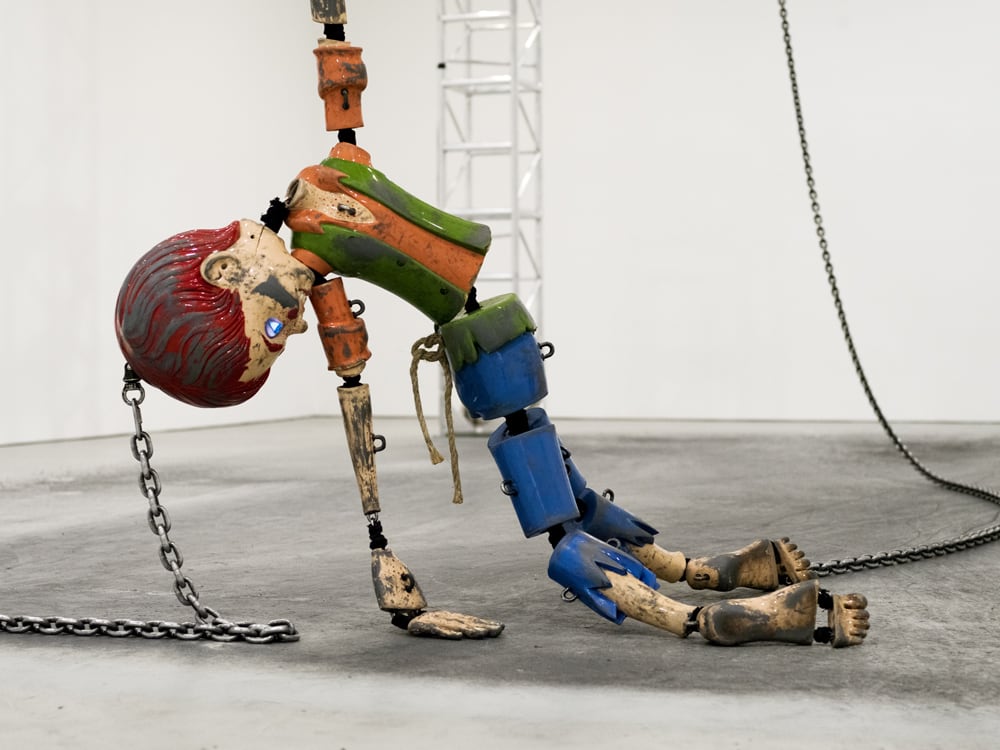
“The note that Real Violence hit – particularly in the context of the Whitney – was a political note,” artist Simon Denny tells me about the film, “And what’s interesting is that Jordan seems to rhetorically dodge that when he speaks about it in public. But, to be honest, it is about that, and it doesn’t matter if the author wants to frame it in that way or not. For me, it’s essentially channelling the politics and escapism of being from a background like his. I think the video explores that territory much more than it explores any sort of ISIS-associative, Internet-viewing violence territory.”
“I just think it’s a red herring,” Sadie Coles tells me, referring to an Internet-based reading of Wolfson, “I think his work primarily has to do with humanity and behavior – with the moral standards society has and how those get misread, bent, twisted, and fucked up.” The process of misreading is an effect often built into Wolfson’s work. It is the motivation behind the disorienting flip at the beginning of Real Violence, but also its Hanukkah prayer, which sparked postulations such as the following from Alexandra Schwartz’s review in The New Yorker: “Hanukkah is a holiday that celebrates the success of an uprising against an oppressor; maybe this was an Inglorious Basterds scenario, an act of vengeance for atrocities committed by the man laid low. (Wolfson, as the museum’s wall text notes, is Jewish.)”
When I ask Wolfson about the meaning of the prayer, he puts down his utensils to draw an imaginary line between his fingers. “It’s like taking a string and bending it,” he says, pulling a third finger across the center of this imaginary line, “It creates a kind of poker face of absurdity to the artwork that negates meaning. They can’t load meaning into it, because it. Just. Doesn’t. Work.”
As Wolfson tells me this, I begin to see this line tracing through the entirety of his work, taking shape in the ironic shamelessness of his character in The Crisis, or in his own internal monologue as an animatronic woman in (Female figure). This sense of counter-meaning stretches outward into our own interactions – the teleporting countryhouse, the Bikram prayers – to a point where I begin to understand that Wolfson’s entire being is invested in this parallel project of searching for feeling and corrupting any significance that may cloud it. The result is something pure, rubberized, and indestructible. It is something grotesque that looks an awful lot like us.
“Do I enjoy attention? Sure! Is being a famous artist fun? Absolutely! Is making art difficult and insane? Yes. And harder than you ever fucking imagined.”
Earlier that day, when I first meet Wolfson at his studio in Red Hook, the artist has just finished meditating. He offers me a glass of iced yerba mate, prepares a protein shake, and tells me about a bad dream he just had. We walk through the studio’s main space, where his artist’s proof of (Female figure) stands in the middle of the large room, mirrorless and exposed with her hips cocked. In the corner, the hardened polyurethane sections that make up Colored sculpture sit neatly inside a wooden crate. The sculptures are being prepared for a shoot by Inez and Vinoodh for Wolfson’s upcoming book, which will feature (Female figure) holding Colored sculpture in her arms like the Madonna in Michelangelo’s Pietà. In the studio’s office, Wolfson and I sink deeply into his couch. We begin talking about his work briefly, before the post-meditation ambiance pulls us into a brief silence.
“It’s all a matter of volume up and down,” Wolfson says, with his fingers in the air, wrapped around an invisible nob, “going from something silent to something incredibly loud.”
Credits
- Text: Thom Bettridge
